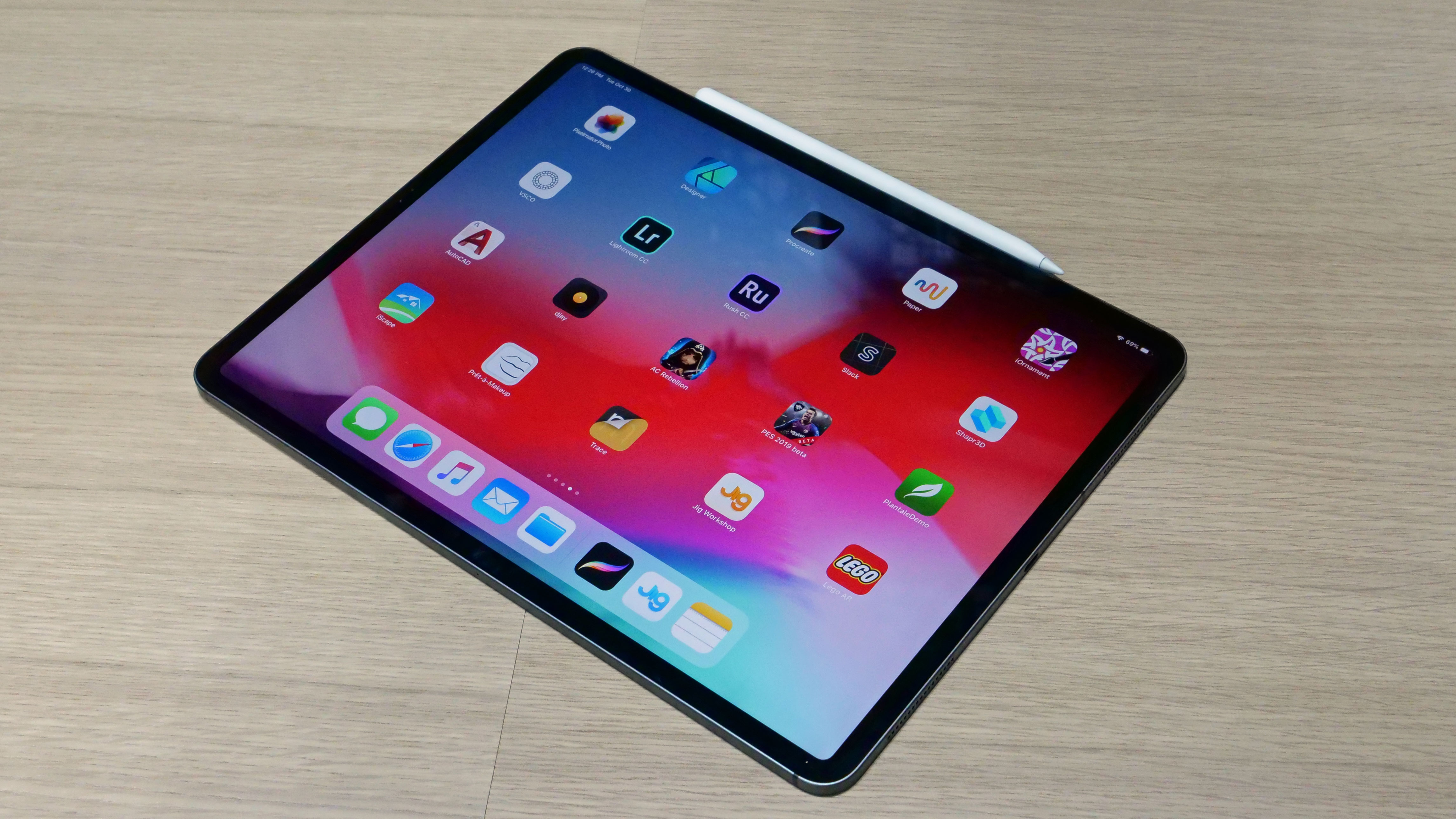iPad Pro 2020 vs iPad Pro 2018: battle of the top-end Apple tablets

It’s been a long time coming, but Apple has finally upgraded its top-end iPad range, releasing a new iPad Pro 11 (2020) and iPad Pro 12.9 (2020) as successors to the iPad Pro 11 (2018) and iPad Pro 12.9 (2018).
The new slates have most of the features and updates you might expect – such as a new chipset – and some you might not expect, such as a LiDAR scanner. But a lot of things also haven't changed.
So to help give you a complete picture of how the iPad Pro 2020 range compares to the iPad Pro 2018 range we’ve compared them in full, looking at their prices, design, display, specs, camera and battery.
iPad Pro 2020 vs iPad Pro 2018 price and availability
The new iPad Pro 11 and iPad Pro 12.9 are both available to order already, with deliveries from March 25, and Apple is no longer selling the 2018 models, so if you still want the older ones you’ll have to find them at a third-party store.
The iPad Pro 11 (2020) starts at $799 / £769 / AU$1,329 for a Wi-Fi-only model with 128GB of storage, and rises all the way to $1,449 / £1,419 / AU$2,429 for a 1TB Wi-Fi and cellular model, with 256GB and 512GB models in between, with all versions coming with or without cellular connectivity.
The iPad Pro 12.9 (2020) is even more expensive, starting at $999 / £969 / AU$1,649 for a 128GB Wi-Fi-only option and going up to $1,649 / £1,619 / AU$2,749 for a 1TB Wi-Fi and cellular one.

The 2018 iPad Pro 11 meanwhile started at $799 / £769 / AU$1,229 for a Wi-Fi-only model with 64GB of storage, and rose to $1,699 / £1,669 / AU$2,549 for a 1TB model with Wi-Fi and cellular.
Sign up for breaking news, reviews, opinion, top tech deals, and more.
Finally, the iPad Pro 12.9 (2018) started at $999 / £969 / AU$1,529 for a 64GB Wi-Fi model and rose to $1,899 / £1,869 / AU$2,869 for a 1TB Wi-Fi and cellular model.
The upshot is that all of these slates are very expensive, but their starting prices are similar (while giving you double the storage with the new 2020 iPad Pro models), and at the top end the latest slates are actually slightly cheaper than the 2018 ones.
That said, the 2018 models are likely to start getting significantly reduced now in stores where they’re still available, given that they’re getting on a bit, have been superseded, and have been discontinued by Apple.
iPad Pro 2020 vs iPad Pro 2018 design
While a lot of things have changed for the new iPad Pro models the design remains very similar to 2018’s.
In all cases you’re getting a metal rectangle with small bezels, and the overall dimensions are the same on the new models as the old. That means both 2018’s and 2020’s iPad Pro 11 is 247.6 x 178.5 x 5.9mm, and both versions of the iPad Pro 12.9 are 280.6 x 214.9 x 5.9mm.

The weights differ, but the difference is negligible. The Wi-Fi-only version of the iPad Pro 11 (2020) is 471g, compared to 468g for the 2018 model, while the 2020 iPad Pro 12.9 is 641g, and the 2018 version is 631g. In most cases the weights go up a tiny bit for cellular models, but the differences are similarly tiny.
The four slates all come in silver or space gray, and none of them have a 3.5mm headphone port.
iPad Pro 2020 vs iPad Pro 2018 display
As you’ve probably noticed, the screen sizes haven’t changed, with both generations coming in 11-inch and 12.9-inch sizes. The resolutions and therefore pixel densities are also the same, with both iPad Pro 11 models coming in at 1668 x 2388 and 264 pixels per inch, and both iPad Pro 12.9 models being 2048 x 2732 and 264 pixels per inch.

The core tech is also similar – all of these models have a refresh rate of up to 120Hz and they all include ‘True Tone’, which automatically adjusts the white balance based on the light in your surroundings.
Plus, they all have a typical maximum brightness of 600 nits, and a wide color display (P3).
iPad Pro 2020 vs iPad Pro 2018 camera and battery
The biggest area of focus on the iPad Pro 2020 models seems to have been the camera, as Apple has added a second rear camera to the new models. So while all of them have a 12MP f/1.8 main snapper, the iPad Pro 11 (2020) and iPad Pro 12.9 (2020) additionally have a 10MP f/2.4 ultra-wide one with a 125-degree field-of-view.
This extra lens enables 2x optical zoom, and the True Tone flash is also brighter on the 2020 iPad Pro models.

Things have changed a bit around the front too, as while all four slates have a 7MP selfie snapper, the iPad Pro 2020 models additionally have a LiDAR (Light Detection and Ranging) scanner, which can improve depth-sensing, which should in turn boost both Portrait mode and augmented reality apps.
And while all four slates support 4K video recording and have five microphones, the 2020 iPad Pro models use ‘studio quality’ mics, which should boost the audio quality of your recordings.
As for the battery, Apple never reveals sizes, but it claims that all four models have up to 10 hours of life when surfing the web over Wi-Fi or watching videos, so it doesn’t sound like there’s any improvement there.

iPad Pro 2020 vs iPad Pro 2018 specs and features
One thing that has had a big upgrade for the iPad Pro 2020 is the chipset, as the new slates use an A12Z Bionic chipset, which Apple claims is faster than the processors in most Windows PC laptops.
That’s up from the A12X Bionic chipset in the iPad Pro 2018 models, which is still very fast and beats most smartphones, but a bit more dated now. In all cases though that’s paired with a neural engine and an M12 co-processor.
Other specs include 128GB, 256GB, 512GB or 1TB of storage in the new models, while the older ones come in the same selection, except with 64GB in place of 128GB. They all also have four speakers.
The slates all run iPadOS, but the iPad Pro 2020 models come with iPadOS 13.4 out of the box, which adds trackpad support. The older models should soon be updated to that, but note that the new slates will probably keep getting software updates for longer.

All of the slates support the latest Apple Pencil and Smart Keyboard, but Apple has additionally launched a new Magic Keyboard, which is only compatible with the 2020 iPad Pro models. This includes a trackpad, backlit keys, and a hinge, so you can use it at lots of angles.
Takeaway
While a lot seems to have changed with the new iPad Pro models, a lot has also stayed the same. The designs, screens and battery life seem very similar to the previous generation, but the iPad Pro 2020 has a newer, more powerful chipset, an extra camera lens, and a LiDAR scanner, as well as more base storage and a lower price at the top end.
Pair the iPad Pro 2020 with the new Magic Keyboard and it’s also likely to be a far more capable laptop replacement than the iPad Pro 2018 – though we won’t know for sure until we’ve put the new models through a full review.
Given how long it has been since the previous models launched, the changes and upgrades here perhaps aren’t as significant as you might hope or expect – and if you’re rocking an iPad Pro 2018 then, on paper, there’s probably not a huge amount of reason for most people to upgrade, especially given the high price.
But the iPad Pro 11 (2018) has sat at the top of our best tablets list for a long time and it’s likely that these new models will beat it, so if you want the very best tablet available then one of the iPad Pro 2020 options is probably it – but you’ll have to wait for our full reviews to be sure.
- Don't need a Pro? Check out our full guide to the best iPads
- Or take a look at the best iPad Pro deals and sales prices available now
James is a freelance phones, tablets and wearables writer and sub-editor at TechRadar. He has a love for everything ‘smart’, from watches to lights, and can often be found arguing with AI assistants or drowning in the latest apps. James also contributes to 3G.co.uk, 4G.co.uk and 5G.co.uk and has written for T3, Digital Camera World, Clarity Media and others, with work on the web, in print and on TV.